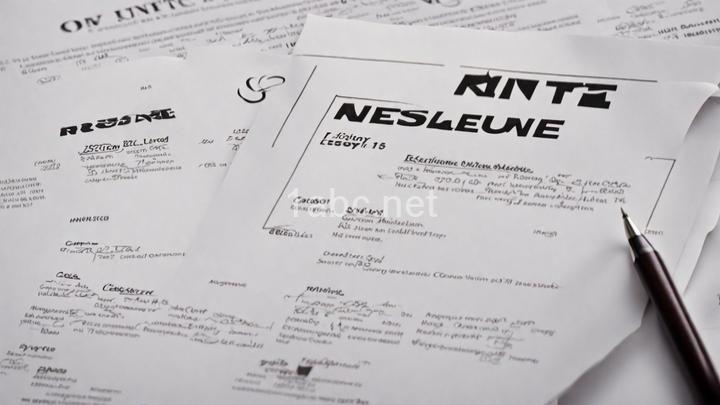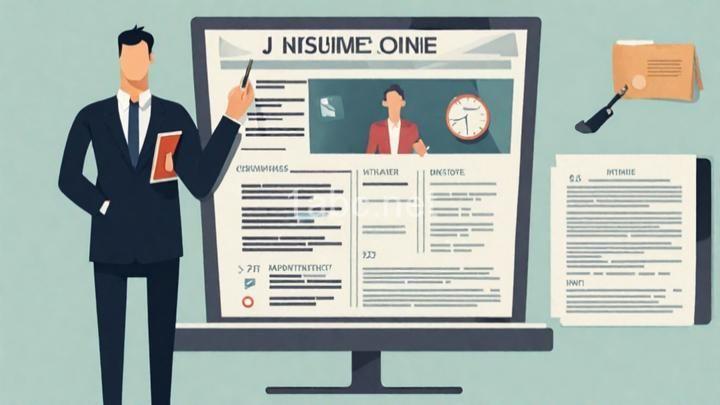Common Resume Mistakes to Avoid at All Costs

Introduction:
Hey there! Looking to create an impressive resume that lands you your dream job? Well, you've come to the right place! In today's competitive job market, a well-crafted resume can make all the difference in whether or not you get hired. Your resume is essentially the first impression you make on potential employers, so it's crucial to avoid common mistakes that can hinder your chances of success. In this blog post, we'll discuss some of the most common resume mistakes and provide practical tips on how to avoid them. So, let's dive in!
I. Lack of Clarity and Focus
One of the most common mistakes job seekers make is failing to clearly define their career goals in their resumes. Without a clear focus, your resume can end up being unfocused and confusing for employers. It's essential to tailor your resume content to align with your career goals and the specific job you're applying for.
Employers are looking for candidates who know what they want and can demonstrate their suitability for the role. When your resume lacks clarity, employers may question your focus and commitment, making it harder for you to stand out from the competition. To avoid this mistake, take the time to identify your career goals and tailor your resume accordingly. Highlight your relevant skills and experiences that directly relate to the job you're applying for, and make sure your objective statement clearly communicates your career aspirations.
II. Typos and Grammatical Errors
Oops! Misspelled words, grammar mistakes, and punctuation blunders can have a negative impact on your chances of being considered for a job. Typos and errors in your resume can make you appear careless or lacking attention to detail in the eyes of potential employers.
To avoid this mistake, always proofread your resume thoroughly before submitting it. Use spell check tools to catch any obvious errors, but don't solely rely on them. Take the time to read through your resume carefully, paying attention to grammar, punctuation, and sentence structure. It's also a good idea to seek assistance from others, such as friends or family members, to get a fresh pair of eyes on your resume. They may be able to catch mistakes that you might have missed.
III. Generic Templates
Using generic resume templates without personalizing them is another common mistake that job seekers make. While templates can be helpful as a starting point, relying solely on them often leads to uninspiring resumes that fail to stand out from the crowd.
Employers are looking for candidates who can demonstrate their unique skills, strengths, and qualifications. Generic resumes don't effectively communicate your individuality and may not capture the attention of employers. To avoid this mistake, customize your resume for each job application. Tailor your objective statement to align with the specific job you're applying for, highlight key achievements that are relevant to the role, and showcase specific skills that demonstrate your suitability for the position.
IV. Lack of Quantifiable Achievements
Resumes that lack measurable achievements may fail to impress employers or demonstrate your potential value to their organization. When your resume only lists job responsibilities without quantifiable results, it can be challenging for employers to gauge your capabilities and accomplishments.
To avoid this mistake, identify and quantify your achievements whenever possible. Instead of simply listing your job duties, focus on the impact you made in your previous roles. Use numbers, percentages, or specific metrics to demonstrate your contributions. For example, instead of saying you increased sales, specify by how much and within what timeframe. This way, employers can see concrete evidence of your skills and accomplishments.
V. Neglecting Keywords and Applicant Tracking Systems (ATS)
Ignoring keywords relevant to the job description and neglecting to optimize your resume for Applicant Tracking Systems (ATS) is a critical mistake. Many companies use ATS to filter out resumes that don't match specific criteria, which means your resume could end up in the rejection pile if you don't optimize it properly.
To avoid this mistake, carefully review the job description and identify keywords that are relevant to the role. Incorporate these keywords strategically throughout your resume, especially in your skills and experience sections. Additionally, ensure that your resume is ATS-friendly by using standard fonts, avoiding excessive formatting, and organizing your information in a clear and structured manner. Make sure important information is easily scannable by these systems to increase your chances of getting noticed.
Conclusion:
In conclusion, creating a strong resume is crucial for your job search success. By avoiding these common resume mistakes, you can significantly increase your chances of landing that dream job. Remember to be clear and focused, proofread meticulously, customize your resume, highlight quantifiable achievements, and optimize for ATS. Your resume is your ticket to standing out from the crowd, so take the time to craft it carefully and avoid these pitfalls. Best of luck with your job search!
FREQUENTLY ASKED QUESTIONS
What are some common resume mistakes that I should avoid?
When it comes to crafting a resume, there are definitely some common mistakes that you'll want to avoid. Here are a few to keep in mind:
-
Spelling and grammar errors: This might seem like a no-brainer, but you'd be surprised at how many resumes contain typos or grammatical mistakes. Take the time to proofread your resume carefully or even ask someone else to review it for you.
-
Lack of focus: Your resume should be targeted towards the specific job you're applying for. Avoid including irrelevant information or going off on tangents. Instead, highlight your relevant skills and experiences that directly relate to the position.
-
Too much information: While it's important to showcase your qualifications, you don't want to overwhelm the reader with too much information. Keep your resume concise and focused, highlighting your most impressive accomplishments and experiences.
-
Listing responsibilities instead of achievements: Instead of simply listing your job duties, try to focus on the accomplishments and results you achieved in each role. Employers are more interested in what you can bring to their organization, so be sure to highlight your achievements and the impact you made.
-
Lack of customization: Sending out a generic, one-size-fits-all resume is a common mistake. Take the time to tailor your resume to each specific job you're applying for. This means tweaking your objective statement, emphasizing relevant skills and experiences, and using keywords from the job description.
Remember, your resume is often the first impression you make on a potential employer, so it's important to avoid these common mistakes and present yourself in the best light possible. Good luck!
How can I make sure my resume stands out from the competition?
To ensure that your resume stands out from the competition, follow these tips:
-
Tailor your resume: Customize your resume for each job application by highlighting relevant skills and experiences that match the requirements of the position. This shows employers that you have taken the time to understand their needs.
-
Use a professional format: Choose a clean and organized layout that is easy to read. Use headings, bullet points, and bold fonts to draw attention to the most important information.
-
Highlight your achievements: Instead of simply listing your job responsibilities, focus on showcasing your accomplishments. Quantify your achievements with numbers or percentages to demonstrate the impact you made in your previous roles.
-
Include keywords: Many companies use applicant tracking systems (ATS) to scan resumes for specific keywords. Research the job description and incorporate relevant keywords throughout your resume to increase your chances of getting noticed.
-
Showcase your skills: Create a dedicated skills section where you can list both hard and soft skills that are relevant to the job. Include specific examples or projects that demonstrate your proficiency.
-
Incorporate visual elements: If appropriate for your industry, consider adding visual elements such as graphs, charts, or infographics to visually represent your skills or achievements. However, make sure they enhance the overall presentation and don't overshadow the content.
-
Proofread and edit: Eliminate any spelling or grammatical errors in your resume by carefully proofreading it. Ask a friend or family member to review it as well, as they may catch mistakes you might have missed.
-
Keep it concise: Try to keep your resume to one or two pages, focusing on the most relevant information. Hiring managers often have limited time, so it's important to make a strong impression quickly.
Remember, a well-crafted resume should effectively showcase your skills, experience, and accomplishments in a way that sets you apart from other candidates.
Are there any formatting errors that recruiters often notice?
Yes, there are indeed formatting errors that recruiters often notice. These errors can have a negative impact on your job application and may cause recruiters to view your resume or cover letter less favorably. Some common formatting errors include inconsistent font styles or sizes, excessive use of bold or italicized text, improper spacing between sections, and inconsistent bullet point formatting. Recruiters also pay attention to the overall layout and structure of your document, so it's important to ensure that it is visually appealing and easy to read. By avoiding these formatting errors, you can present yourself as a well-organized and professional candidate.
What information should I include in my resume?
When crafting your resume, it's important to include key information that will make you stand out to potential employers. Here are some essential details to include:
-
Contact Information: Start with your name, phone number, email address, and LinkedIn profile (if applicable). Make sure this information is easily visible at the top of your resume.
-
Professional Summary: Write a concise paragraph summarizing your skills, experience, and career goals. This section should give employers a snapshot of who you are as a professional.
-
Work Experience: List your previous jobs in reverse chronological order, starting with the most recent. Include the company name, job title, dates of employment, and a brief description of your responsibilities and achievements in each role.
-
Education: Include your highest level of education, including the degree earned, institution attended, and graduation date. You can also mention any relevant coursework, honors, or certifications.
-
Skills: Highlight your key skills and abilities that are relevant to the position you are applying for. This can include technical skills, such as programming languages or software proficiency, as well as soft skills like communication and leadership.
-
Achievements: If you have any notable achievements or awards, include them to showcase your accomplishments.
-
Additional Sections: Depending on your background, you may want to include additional sections such as projects, volunteer experience, professional affiliations, or languages spoken.
Remember to tailor your resume to each specific job application by emphasizing the skills and experiences that align with the job requirements. Keep it concise and easy to read, using bullet points and clear headings. Proofread carefully to ensure there are no typos or grammatical errors. Good luck with your resume!



